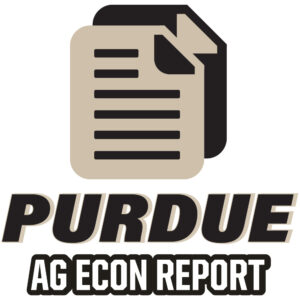Valuation of land grant university education under COVID-19: students’ willingness-to-pay for alternative study options
April 26, 2022
PAER-2022-12
Yizhou Hua, Ph.D. Candidate; Holly Wang, Professor of Agricultural Economics; and Christine Wilson, Professor & Associate Dean at College of Agriculture
Background
The outbreak of the COVID-19 pandemic, once causing confrontation between students and universities over tuition charged, has prompted us to well consider differential pricing on alternative study options. Universities may accommodate students’ needs in tuition-setting process to maintain competitiveness and attractiveness. In our study, we aim to elicit students’ willingness-to-pay (WTP) for alternative study options. Meanwhile, we examine factors that account for why WTPs vary among students.
Data Collection
We have conducted a survey at Purdue in 2021, with undergraduate students being recruited from three representative colleges, respectively College of Agriculture, College of Liberal Arts, and College of Sciences. 606 complete responses were received. Overall, our sample aligns well with Purdue university’s undergraduate population (Table 1).
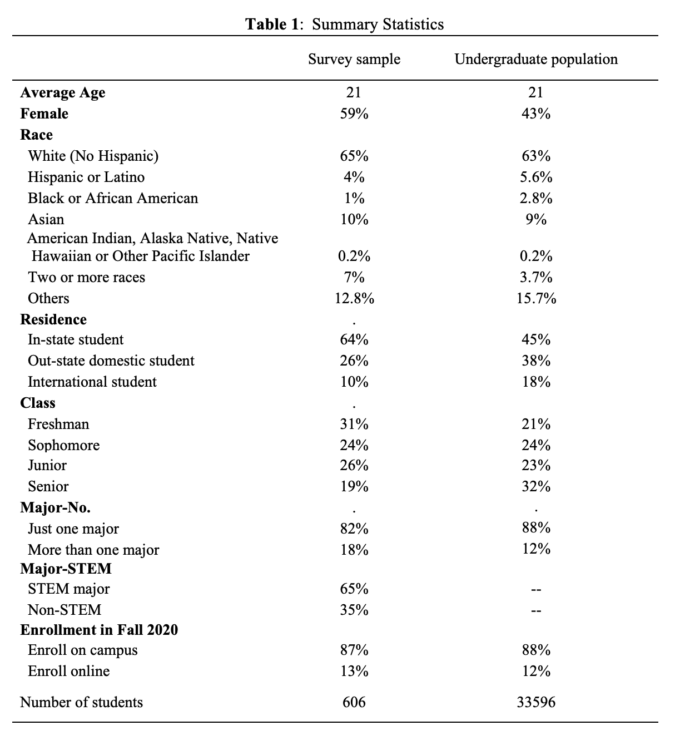
Table 1: Summary Statistics
To elicit students’ WTPs, we employed a discrete choice experiment in our survey. Five key college education attributes relevant to COVID-19 were identified after working with a focus group of students. They include course study options (in-person, hybrid, fully online), test format (monitored or unmonitored), and campus facility opening policy (fully open, restrictedly open); tuition ($4000, $4500, $5000, and $5500 per semester) and the types of extracurricular activities available for students to participate in (0, 2, 4). Students would state their preferences by making a choice among three alternatives in multiple choice sets (Figure 1).
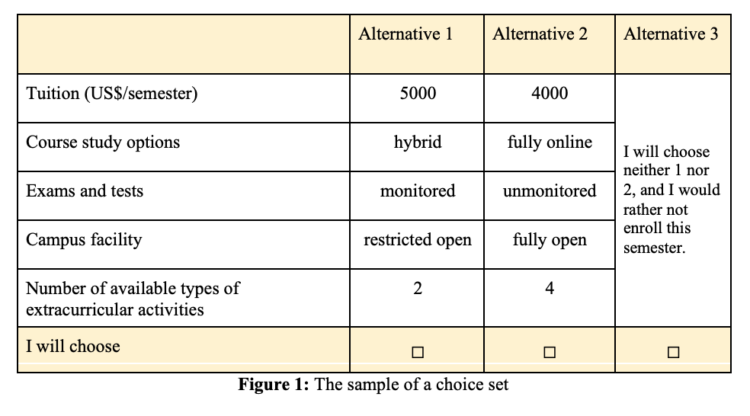
Figure 1: The sample of a choice set
Analysis & Results
Table 2 displays the Random Parameter Logit (RPL) regression results and derived mean WTP. From Column (2), we could see that compared with online instruction, in-person delivery is most preferred ($1545) and then follows hybrid ($1161). In other words, if setting the basic in-person tuition rate $5000 per semester, students may demand $1545(31%) and $384 (7.6%) tuition discount for fully online and hybrid options respectively. They prefer their tests unmonitored ($794) and campus fully open ($283); they are willing to pay more for engaging an extra type of extra-curriculum activities ($266).
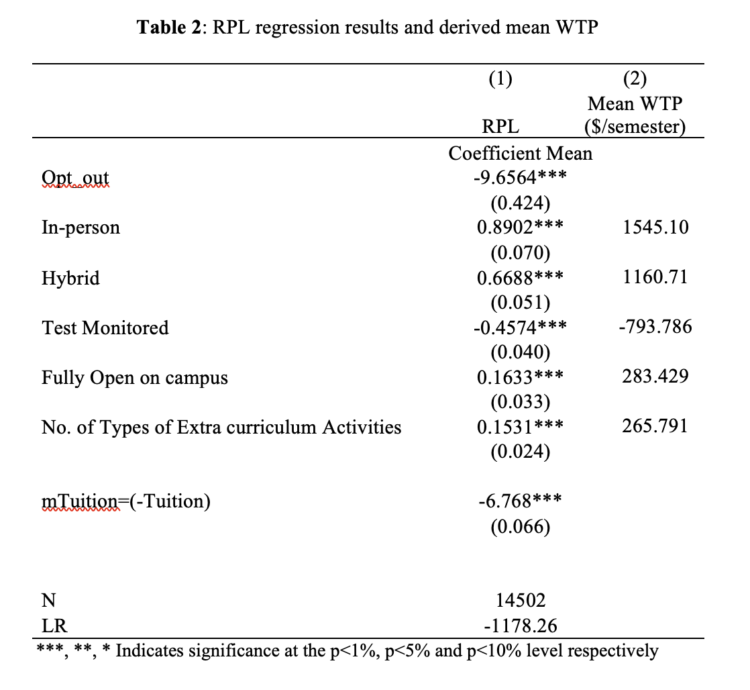
Table 2: RPL regression results and derived mean WTP
***, **, * Indicates significance at the p<1%, p<5% and p<10% level respectively
Table 3 shows how factors account for the heterogeneity of individual WTPs among students for in-person and hybrid study options (relative to the online option). Coefficients in Column (2) for the hybrid follow the similar pattern in Column (1) for in-person but with less magnitude. For convenience of analysis, we focus on Column (1) by examining how factors contribute to individual WTPs for the in-person study option. It could be interpreted as follows:
First, students with demographic characteristics like white, male, freshman have higher WTP for in-person instruction (relative to fully online instruction) than their counterparts, respectively amounting to $187, $114, and $252. On-campus education could enable students to get access to facilities, organization and social events on campus while facilitating their social networking, especially for the freshman who desired for brand-new college experience.
Second, learning environment and learning outcome play pivotal roles in WTPs difference among options. While living far-off campus may reduce students’ WTP for in-person instruction by $894, technical issue occasionally encountered online will offset against the reduction by $496. Student’s valuation for in-person education by GPA scores (0-4 points) “before Fall 2020” (GPA for all attempted courses before Fall 2020) and “during Fall 2020” (GPA for courses chosen in Fall 2020) were also analyzed. Interestingly, one-unit increase in overall cumulative GPA till Fall 2020 and term GPA in Fall 2020 has contrasting effects ($888 and $-605 respectively) on WTPs for the in-person option (relative to the online). This means that up to Fall 2020, students were willing to pay 888$/semester more for in-person education for one-unit increase in cumulative GPA. Yet during Fall 2020 for one-unit increase in term GPA, students were willing to pay $605/semester more for the online study option. This may be related with less rigorous assessment in fall 2020 education during COVID-19. In other words, students may find it more attractive to have online education, due to less rigorous exams under context of COVID-19, to increase term GPA in Fall 2020. Hence, they would prefer online over in-person instruction. However, the cumulative GPA till Fall 2020 reflects the fact that if following previously rigorous assessment criteria, to increase scores students may be more accustomed to in-person instruction and would prefer it.
Third, economic factors and majors where students are in also affect students’ WTP for in-person option. Students employed for part-time job have higher WTP ($297) for in-person option compared with fully online option. That is explained by the fact that most of part-time jobs available for students are on or near campus, such as teaching, research, general assistant. Yet an hour spent on working will decrease WTPs for in-person option by $ 22, in comparison with that spent on extra-curricular activities which increase WTP by $13.
Fourth, students who major in STEM, which requires more hand-on experience and in-person interaction, also have higher WTPs for in-person instruction. Students studying in only one STEM major or multiple majors involving STEM have higher WTP of $ 91 or $ 216 than their peers who only pursue one non-STEM major.
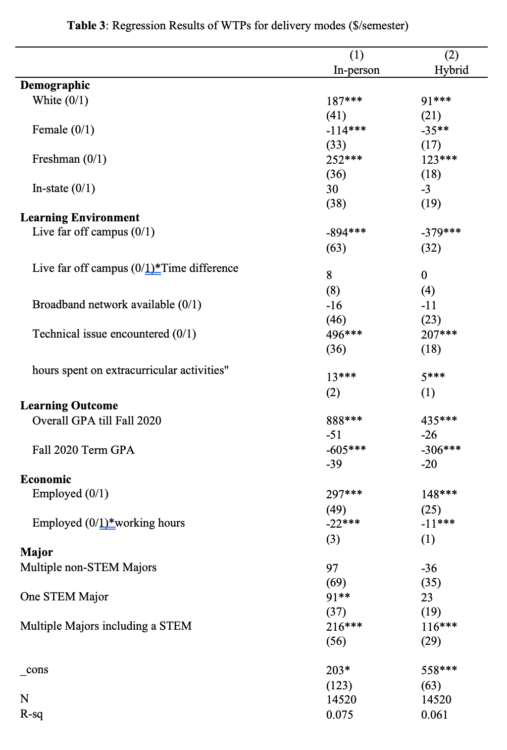
Table 3: Regression Results of WTPs for delivery modes ($/semester)
Summary
Our result shows that undergraduate students overall are willing to pay $1545 (31%) and $384 (7.6%) less for online and hybrid options respectively compared with in-person study option, given the basic tuition rate $5000 per semester. Factors, categorized by demographic, learning environment, learning outcome, economic and majors could to some extent account for why their WTPs vary among undergraduate students.
